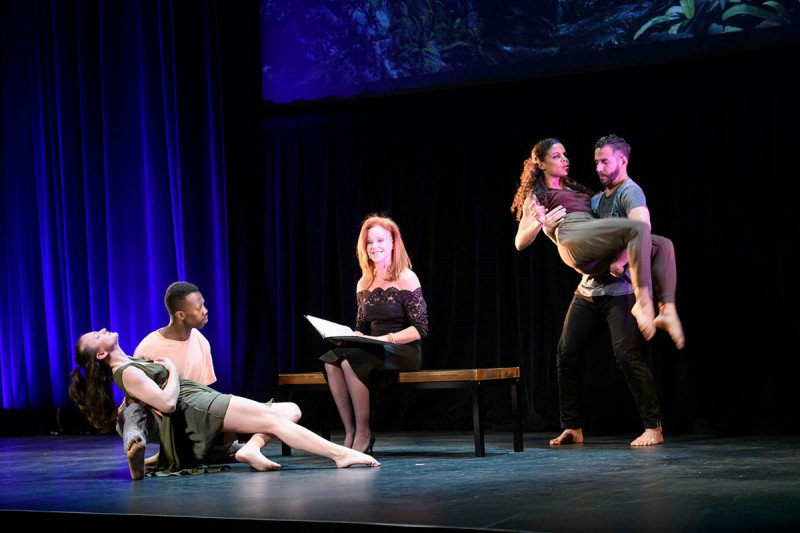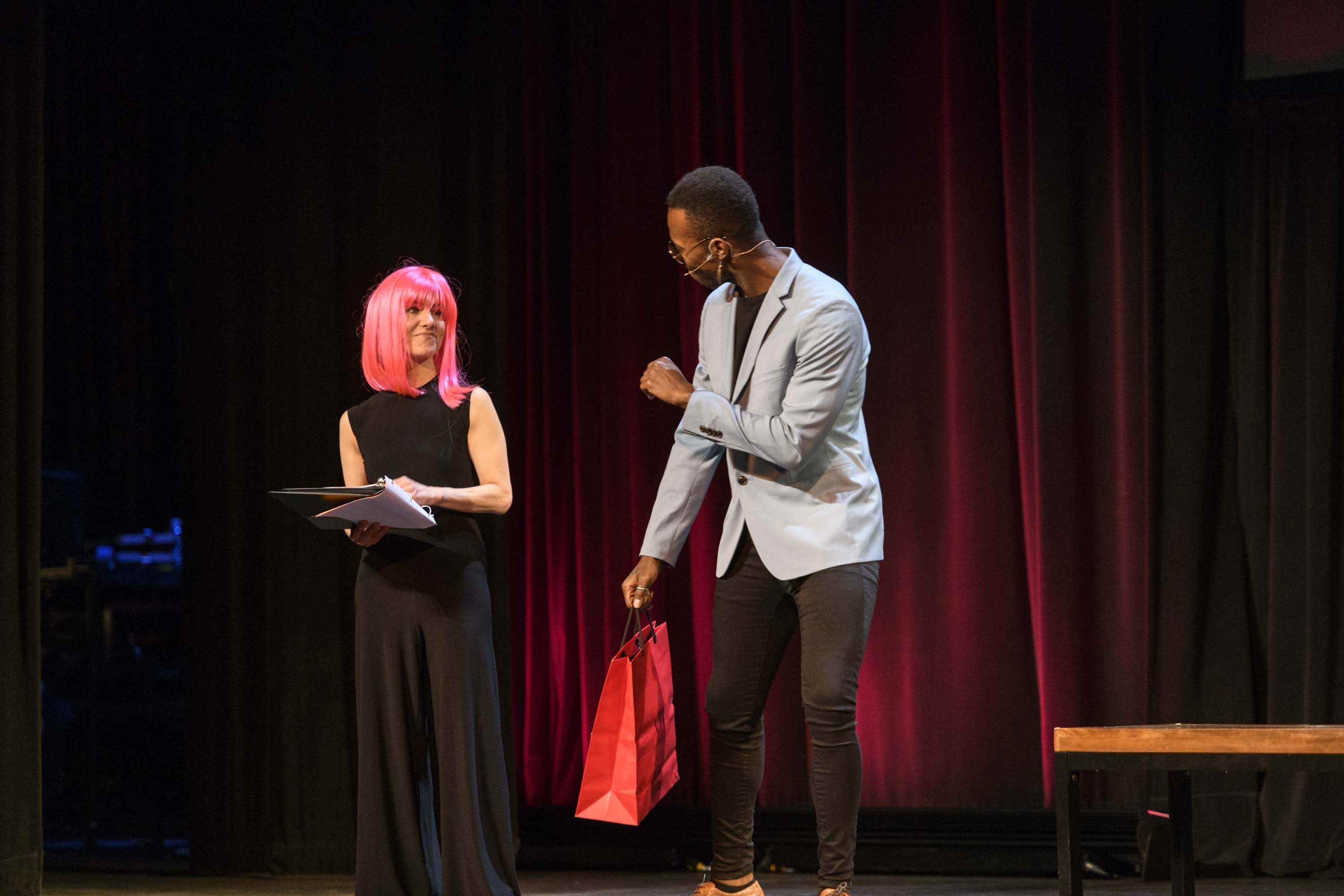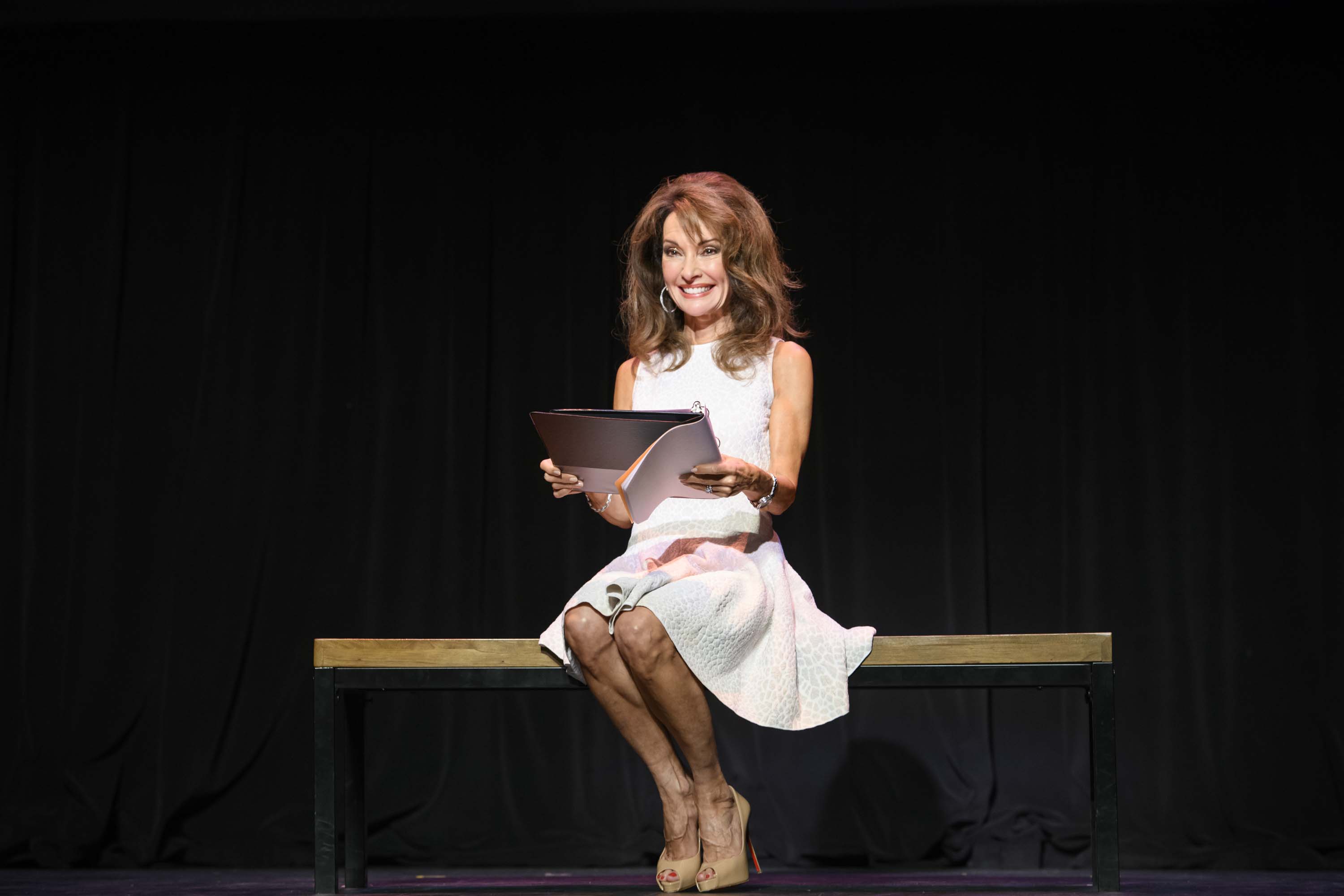
Dancers accompanied actress Kathryn Mowat-Murphy (center) as she read a piece by an MSK patient as part of the Visible Ink performance.
As the lights dimmed on the Kaye Playhouse at Hunter College, the sellout crowd of hundreds hushed and turned their attention to the stage and actress Karen Wexler, wearing a hot pink wig. Ms. Wexler was reading the funny, poignant words of Memorial Sloan Kettering patient Megan Hughes, who described her lighthearted way of coping with the cancer that caused her to lose her hair.
Ms. Hughes is part of Visible Ink, a writing program for MSK patients founded by Judith Kelman in 2008. Each year, the program holds a staged reading of patients’ works performed by Broadway actors, singers, and dancers. This year’s event — the tenth anniversary performance — featured veteran actors Susan Lucci and Marin Mazzie among the talent.
See below for highlights from the performances.

In “A Simple Thank You” by Megan Hughes, the author described her affection for the pink wig she wore after she lost her hair from cancer treatment and the joy it brought her. “I never knew what people were going to say or how they would react,” she said in the piece, which was read by Ms. Wexler. “One night, as I walked home, a kind gentleman walked up to me and whispered in my ear, ‘I love your wig. I have the same one.’ … I don’t know why I said, ‘I’m going through chemo right now,’ but I did. He looked at me with smiling eyes and said, ‘Oh child, you’re going to make it. Just look at you and how you’re carrying yourself!’
“I couldn’t help but grin as I realized what he said. I looked good, I felt good, and I was going to make it.”

A plastic bird heist was the subject of “Pretty Flamingo” by William John Rostron, read by Robert Montano. When his girlfriend prepared to leave their New York City neighborhood, Mr. Rostron took out his frustration at her departure by rounding up the lawn ornaments that dotted the neighborhood and planting them on her family’s small patch of grass in protest. Two close friends helped him in his quest. “When every inch of the grass was covered with our pink friends, we filled the concrete, railing, and exterior walls with the overflow birds,” he wrote. “We would have liked to stay and watch their reaction but thought better about being caught pink-handed.”

“Harmony Amidst MRI Dissonance,” by Courtney Vashaw, featured Broadway actress Marin Mazzie. Broadway numbers were interspersed throughout the performance, and finished with a moving rendition of “Hallelujah” by the group of singers. The piece was based on Ms. Vashaw’s experiences in cacophonous MRI machines. To counteract the noise, she listened to showtunes during her scans.
“At the end of the day, when you feel as if you might explode if you don’t cough and that last cc of fluid they pushed through that IV is going to make you burst, ‘Hallelujah’ manages to make itself heard under the drone, and the key is somehow just about right,” she wrote.

Claire Harris Tunick wrote about the death of her daughter Dana at age 43 from a cardiac arrhythmia in “She Comes to Me Through Music.”
As Lucy Martin read from the piece, after Dana’s death, “my husband, daughter, and I [were] faced with a huge void and [were] left with the nagging, unanswerable question: Where is she?”
She continued, “I cannot answer my own question. But I can choose to believe that there is some uncertain something that keeps Dana’s spirit near those who cherished her. I will always see her in the beauty of the changing leaves, feel her in a warm breeze, sense her in a dream, and hear her in a song.”

The soap opera actress Susan Lucci read one of the last works of the night, “You and Me,” by Erin Geddis Cummings, in which the author wrote to thank her writing mentor, Bill Persky. Mr. Persky is a director and screenwriter known for The Dick Van Dyke Show and The Mary Tyler Moore Show. When she was paired with Mr. Persky, Ms. Geddis Cummings wrote, “I was terrified. I wasn’t even sure I wanted to be a writer. I just wanted to tell a story—a story of being a lonely, scared teenager who was given a lousy prognosis but survived anyway. I did not have a background in writing. I had not written anything more poignant than a holiday letter.”
But after working together and seeing a Visible Ink staged reading in which other patients’ stories were read, Ms. Geddis Cummings was moved to share her story too. Mr. Persky gave her the confidence to make it happen. “You had much more faith than I did,” she wrote to him. “I think you still do. But Judith [Kelman, Visible Ink’s founder] was right—we make a pretty good team.”
